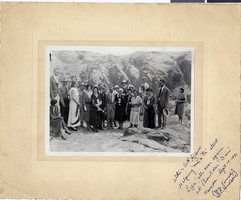Search the Special Collections and Archives Portal
Search Results
Tomiyasu Family Photograph Collection
Identifier
Abstract
The Tomiyasu Family Photograph Collection (approximately 1908 to 1991) consists of black-and-white photographic prints of the Tomiyasu family and their farming business in southern Nevada.
Archival Collection

Postcard showing a street scene in Boulder City, Nevada, circa 1933-1955
Date
Archival Collection
Description
Image
Ronzone, Richard James, 1917-1989
Richard “Dick” J. Ronzone (1917-1989) was active in the local politics and civic affairs of Las Vegas, Nevada, serving as a Clark County Commissioner, a Nevada State Assemblyman, and a member of the University Board of Regents. He inherited and managed his family's retail store which dated back to the early 1900s. Ronzone also helped develop the Municipal Golf Course and was active in the Elks Lodge, Rotary Club, Veterans Of Foreign Wars, Reserve Officers Association, and the Boulder Dam Area Council of the Boy Scouts of America.
Person

Photograph showing an aerial view of the Mike O'Callaghan-Pat Tillman Memorial Bridge, Nevada-Arizona border, April 10, 2012
Date
Archival Collection
Description
Image

Photograph showing an aerial view of the Mike O'Callaghan-Pat Tillman Memorial Bridge, Nevada-Arizona border, April 10, 2012
Date
Archival Collection
Description
Image

Electrians that it took to work on the Hoover Powerplant: photographic print
Date
Archival Collection
Description
Image

Photograph of Alta Ham, Art Ham, and others, Boulder Dam, Nevada, September 13, 1931
Date
Archival Collection
Description
Image
Pacific Engineering and Production Company of Nevada (PEPCON) Disaster Collection of News Articles
Identifier
Abstract
The Pacific Engineering and Production Company of Nevada (PEPCON) Disaster Collection of News Articles (1988-1992) consists of articles from Las Vegas and other state and regional newspapers about the PEPCON plant explosion that took place in May of 1988. Also included are United Press International press releases from October to December, 1988.
Archival Collection
